Page added on January 7, 2016
Where Actually is that Much-hyped Global Oil Glut?
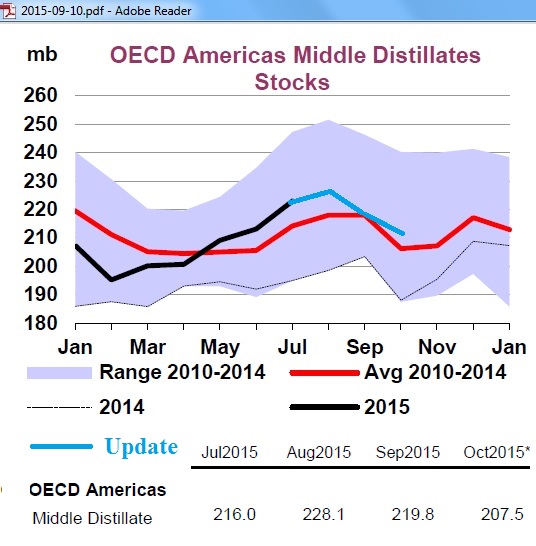
The media is full with news that there is a global oil glut.
There are now more than 3bn barrels of excess oil in the world 13/11/2015
Record oil glut stands at 3bn barrels 13/11/2015
It was parroted by the Australian public broadcaster ABC TV, using this (unsuitable) opportunity to take a swipe at peak oil:
Peak oil losing credibility as renewables shift accelerates 24/12/2015
“With the world awash with too much crude oil at the moment, the fear of an economic catastrophe when fossil fuels start running out is quietly fading in the background.”
These stories go back to the IEA’s Monthly Oil Market Report (OMR), November 2015 which reads:
“Stockpiles of oil at a record 3 billion barrels are providing world markets with a degree of comfort. This massive cushion has inflated even as the global oil market adjusts to $50/bbl oil.”
So how much is 3 bn barrels?
Let’s have a look at the statistics in the latest IEA OMR of December 2015. It’s only about OECD stocks, not the whole world.
Fig 1: OECD total oil stocks
https://www.iea.org/media/omrreports/fullissues/2015-12-11.pdf
We see that oil stocks in the period 2009 (light blue line) to 2013 (dotted line) varied between 2,6 bn and 2.8 bn barrels along with seasonal changes. The average stocks for this time of the year is 2.7 bn barrels. We can consider this range as the result of normal operating conditions allowing for accidents, refinery maintenance, transport disruptions, strikes etc but also demand side changes from a weak economy (2009) to high oil prices (2013).
Therefore, that magic glut is 3 bn – 2.7 bn = 300 million barrels or roughly 10% of the average. The long term trend of OECD stocks is shown in the next graph:
Fig 2: OECD stock changes since 1988
In 1988, average stocks were 2.5 bn barrels One can put many trend lines into Fig 2, depending on which period one selects and which exceptional events are excluded. OECD consumption peaked in 2005 at 23% higher than in 1988 but is now only 11% higher. So one would expect average stocks also to be higher accordingly, at around 2.8 bn barrels.
Regional distribution of OECD stocks
So where exactly is that so-called glut?
OECD Europe
Fig 3: Europe total oil stocks
European total oil stocks (crude plus products) are in the upper range.
Fig 4: Europe crude oil stocks
European crude stocks are also at the upper end of the range, but that’s not really a glut.
Fig 5: Europe gasoline and distillate stocks
Europe’s gasoline stocks are average, but distillates are 18% higher. Half of that higher stock results from an unseasonal increase in the Netherlands.
Fig 6: Middle Distillate Stocks in Germany and Netherlands
The reason for higher stock-levels in the Netherlands is that products cannot be easily transported on the river Rhine which experienced low water levels for many months in 2015, due to lack of rainfall in the catchment.
Fig 7: Tankers can’t take full load due to low water levels on river Rhine
Shrinking Rhine: shipping scrapes by as river stays at lowest level for 40 years 12/11/2015
European ‘extreme weather belt’ linked to worst drought since 2003
OECD Asia Oceania
Australia, Japan, Korea
Fig 8: Asia Oceania total oil stocks
Total oil stocks in Asia Oceania are slightly above the usual range and 5% above average.
Fig 9: Asia Oceania crude oil stocks 21% above average
Fig 10: Asia Oceania total product stocks 7% below average
OECD Americas
US, Canada, Mexico
Fig 11: Americas total oil stocks
Ah, here we finally have a large part of that magic glut, around 190 mb, 15% higher than average and around 7 days of forward demand, most of it crude in the US:
Fig 12: US commercial crude stocks 100 mb > average
Fig 13: US crude stocks by region
Fig 14: Americas distillate stocks around average
Fig 15: America’s gasoline stock a bit above average
Summary OECD
Let’s put all this in 2 summary graphs
Fig 16: OECD stock changes in comparison to 5 year average
Fig 16 shows that 2/3 of the above-average oil stocks are in America, mainly in the US. 46% is crude oil, most likely light tight (shale) oil (LTO) including condensate which requires special refining. 15% are other products like LPG, also coming mainly from LTO. 7% of additional stocks are NGLs, much of it from shale gas.
When the tight oil boom started in 2010/11 there were following phases/options to accommodate growing quantities of LTO
- Replacement of light oil imports of similar grade (eg. From West/North Africa)
- Blending with medium and heavy crudes (however resulting in refining inefficiencies and different product mix)
- Increased capacity utilisation of existing refineries
- Debottlenecking refineries by e.g. modifying the atmospheric distillation unit
- New stabilizers, splitters and hydroskimmers
It seems options 1-4 have been exhausted. It could well be that tight oil inventories went up as phase 5 is too slow and expensive.
Next option is to export:
Congressional Leaders Agree to Lift 40-Year Ban on Oil Exports 16/12/2015
Fig 17: OECD stocks and changes compared to 5 year average
Fig 17 is a zero scaled graph showing the average stocks 2010-14 (dark green, grey and red columns) and the additional stock build until October 2015 (light green columns) for each of the 3 OECD regions. Only 57% of the total stocks of 2.97 bn barrels have really grown (dark green columns) by 10% (light green columns) to arrive at a 67% share. 17% have increased by less than a negligible 3% (grey columns) and 16% have actually decreased.
Whether LTO stocks will remain at current levels will be interesting to watch as US oil production seems to have peaked.
Singapore
Fig 18: Singapore product stocks slightly above range
Fig 19: China product stocks
Chinese oil consumption has increased by around 20% since 2010. A similar increase in peak stocks would require 180 mb. Compared to OECD countries China’s product stocks per 1 mb/d product consumption are much lower so there is no case of stocks being too high.
Conclusion
It is misleading to say the world sits on excess stocks of 3 bn barrels of oil, 2.7 bn of which are already needed in both crude and product stocks for a smooth operation of the refining and distribution system. Most of the stock build since mid 2014 seems to be related to US light tight oil which refineries could not accommodate due to their original designs.
4 Comments on "Where Actually is that Much-hyped Global Oil Glut?"


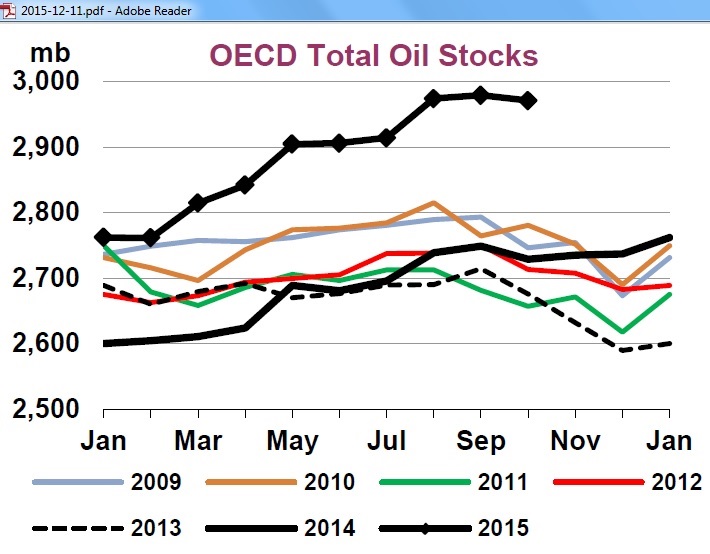
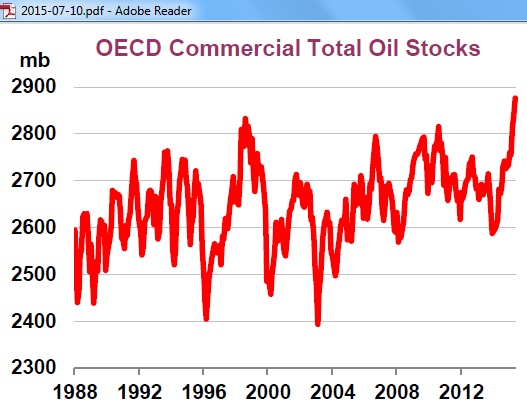
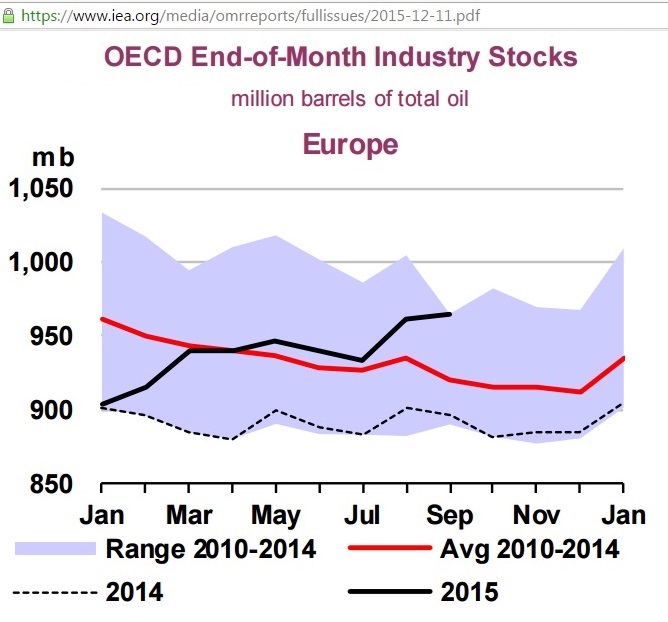

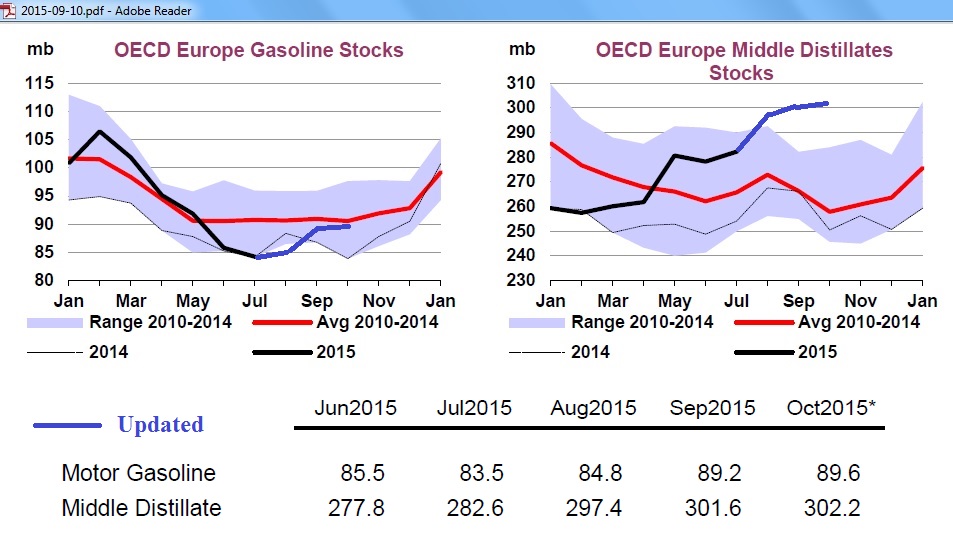
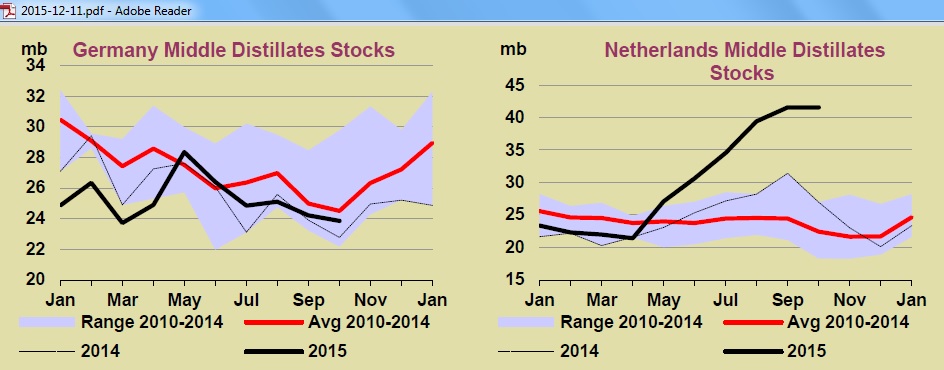



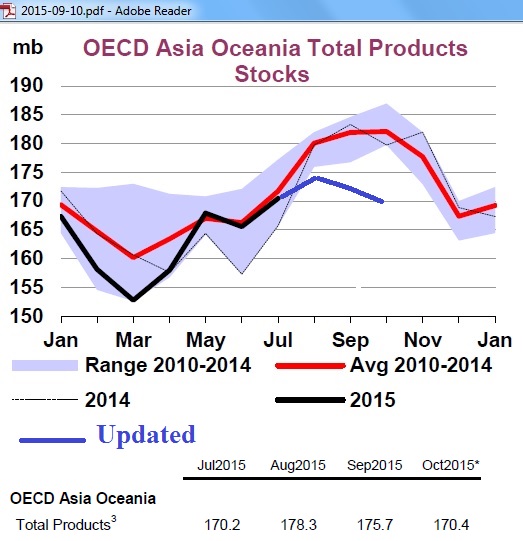



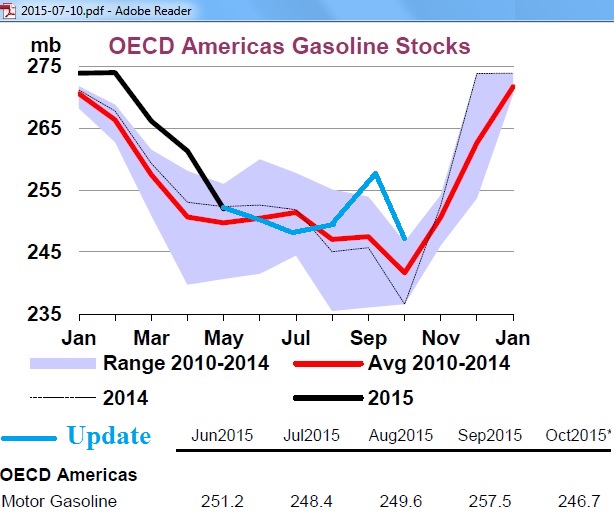
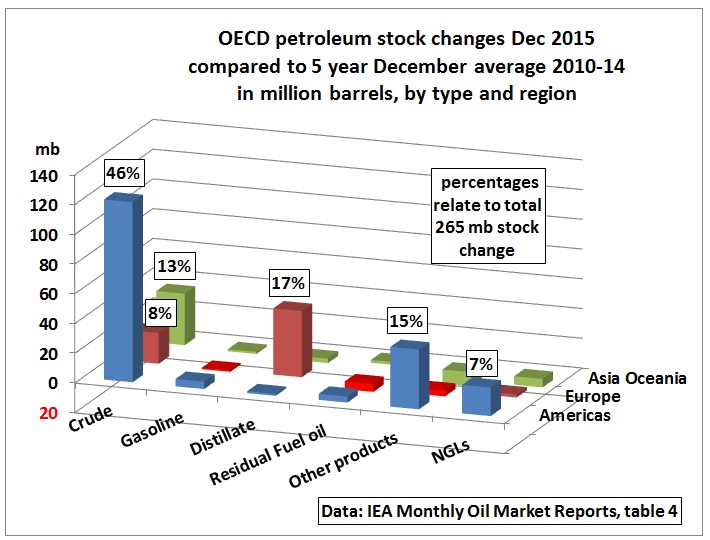



JuanP on Thu, 7th Jan 2016 7:50 am
Jim Rogers on oil prices, https://www.rt.com/op-edge/328161-russia-china-oil-prices-rogers/
rockman on Thu, 7th Jan 2016 9:37 am
“Most of the stock build since mid 2014 seems to be related to US light tight oil which refineries could not accommodate due to their original designs.” Likewise refineries could not accommodate heavy oils due to their original designs. Which is why the US imported light oils top blend with our heavy oil imports. The boom in US light oil reduced the need for those imports. A significant volume of US oil exports today involves exporting our light oil production to Canadian refineries that use it to blend with their heavy oils.
In general refineries are designed to process blended oil with a very narrow gravity range: 31 API to 33 AOI.
shortonoil on Thu, 7th Jan 2016 11:51 am
“It is misleading to say the world sits on excess stocks of 3 bn barrels of oil,”
Obviously, this has absolutely nothing to do with that fact that oil is $33/ barrel today, and most of the world’s producers are going broke. All the pretty charts, and graphs simply mean that someone is trying very hard to selling something. Looks like a line of BS from here!
Keith on Fri, 8th Jan 2016 7:55 am
I saw this post at “crude oil peak” and thought it was a very useful one. It shows that when Bloomberg hypes the 3 B barrel storage figure it was completely out of context. 240 – 300 M bbls excess over the last 18 months is around 500 k bopd excess to market needs. Given Opec has been producing at around 1.3 M bopd over quota since February last year, normal production is actually around 500 k bopd less than requirements. The implication is that a relatively modest production correction, such as predicted by EIA and others, will balance markets. Good that this is published here and has a wider audience.